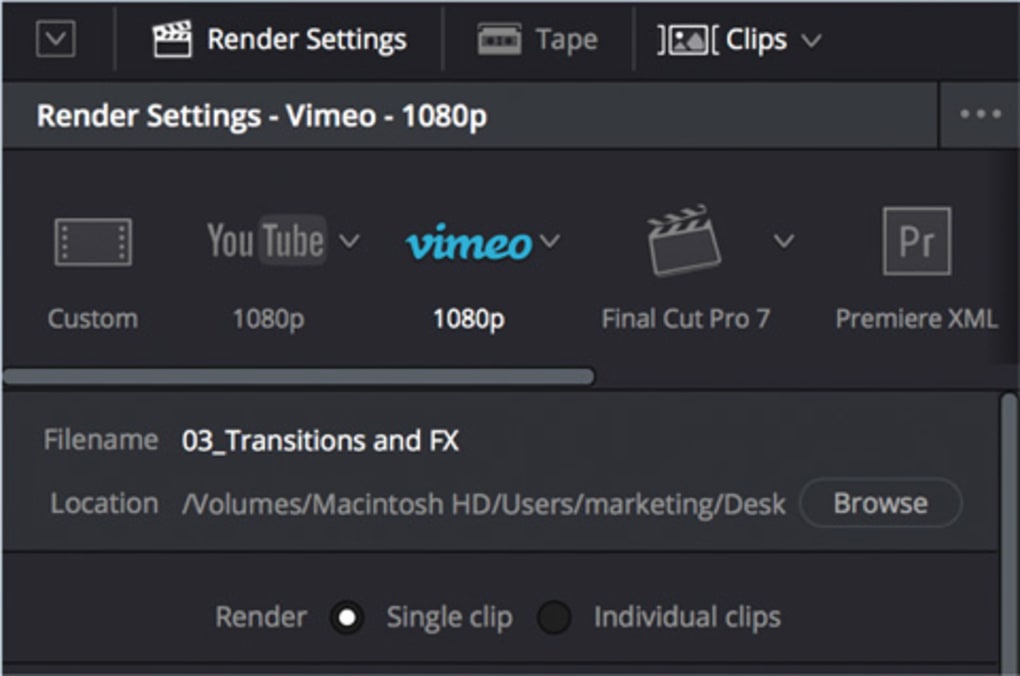

- #WHERE DOES DAVINCI RESOLVE SAVE PROJECTS MAC HOW TO#
- #WHERE DOES DAVINCI RESOLVE SAVE PROJECTS MAC FOR MAC#
- #WHERE DOES DAVINCI RESOLVE SAVE PROJECTS MAC PRO#
- #WHERE DOES DAVINCI RESOLVE SAVE PROJECTS MAC SOFTWARE#
- #WHERE DOES DAVINCI RESOLVE SAVE PROJECTS MAC DOWNLOAD#
Open the Titles sub-menu (farthest to the right), and open up the Inspector.Open the Tools Belt found just underneath the video window.Be sure to place the title above your video on a new layer. Click-and-drag “Text” (fifth option from the top of the list) into the timeline.Open the Titles panel, found in the top-left of the interface.Text+ titles certainly have more possibilities but can take a very long time for your computer to render, and isn’t the easiest tool to learn. Titles can be either 2D or 3D, can feature dynamic lighting, 3D shapes, and particle effects.
#WHERE DOES DAVINCI RESOLVE SAVE PROJECTS MAC SOFTWARE#
Text+ is a more sophisticated tool based on Blackmagic’s compositing software Fusion. You can change fonts, add a drop shadow, and even add a colorful background shape to help separate the text from the video. Text is for quickly generating 2D titles. Step 3: Add Text & TitlesĭaVinci Resolve includes two different text tools: Text and Text+. To change the length of a shot (make something longer or shorter), hover your mouse at the beginning or end of a clip in your timeline to trim any of your shots. To build an assemble edit, watch, and log all of the clips you’ve imported into your project. To review your edits, click on the timeline, drag the playhead to the beginning of the timeline, and press the Spacebar for your rough cut to start playing.

Here, you’ll navigate to where on your computer your footage is stored, to bring into your project.

This defaults to 24 fps, but ideally, you will change this to match the majority of your footage (such as 23.976 or 25 fps).
#WHERE DOES DAVINCI RESOLVE SAVE PROJECTS MAC HOW TO#
How to Edit & Export in DaVinci Resolve 17
#WHERE DOES DAVINCI RESOLVE SAVE PROJECTS MAC DOWNLOAD#
We are going to be using DaVinci Resolve 17.4.3 (that’s the free edition, Studio is the paid version), which can be found for download here.

Whether you are new to video editing or looking to jump ship from another piece of software, this tutorial will show you how to use DaVinci Resolve to get you up and running fast. Not only will you find a complete set of user-friendly video editing tools, but there are also audio mixing and visual effects compositing workspaces! Fueled by a surprisingly capable free version, and the constant addition of new features, the software is now more popular than ever. These are all optional.In recent years, DaVinci Resolve has been steadily gaining interest from professionals and hobbyists alike.
#WHERE DOES DAVINCI RESOLVE SAVE PROJECTS MAC PRO#
Make sure that you have the same version of Premiere Pro on any computer that you‘re using (two can be logged into your Adobe ID at a time regardless of OS).Īs far as the cloud part goes, you can set your Auto-Save location to your Creative Cloud storage, your Premiere Pro settings can sync to it, and you can access files stored in your Creative Cloud storage (if you’re using it) via the Libraries tab in Premiere Pro.
#WHERE DOES DAVINCI RESOLVE SAVE PROJECTS MAC FOR MAC#
You probably already have the drive formatted as ExFAT for cros–platform use, but you could also go with NTFS is you have Paragon NTFS for Mac installed on your MacBook Pro or HFS+ if you have MacDrive for Windows on your Windows desktop. I’ve found it helpful to create a folder on the drive for the entire project (meaning everything for this edit, not just the PR project file) and then create at least three sub-folders: Source Footage, Project Files, Exports. Set the hard drive that you’re using for all of your files as the location for your Premiere Pro project file and you’re good to go.


 0 kommentar(er)
0 kommentar(er)
